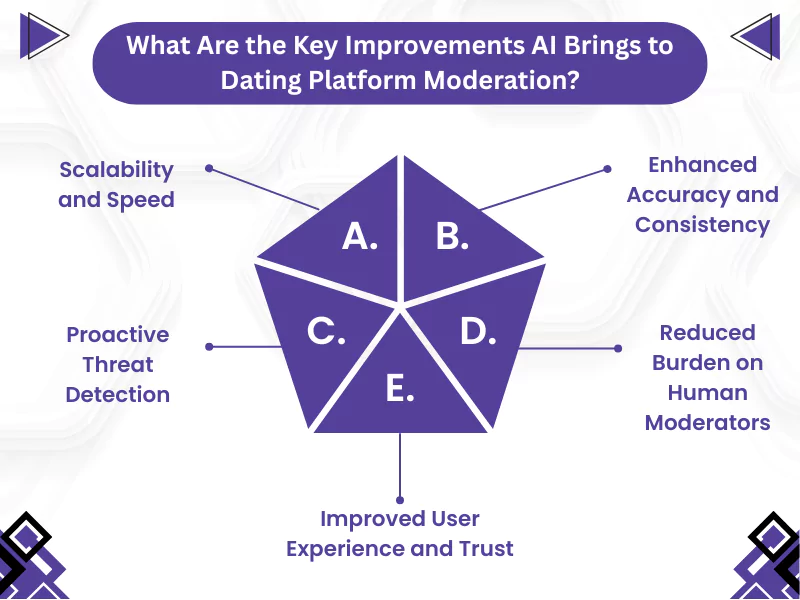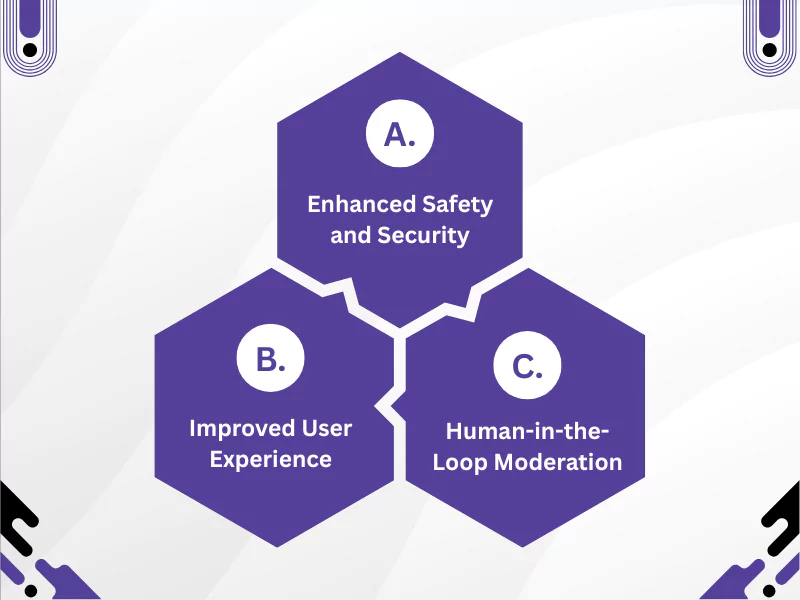The technological evolution and emergence of AI and ML have made digital images both a critical asset as well as a challenge. Organizations are continually adapting to new technologies every day to manage digital image data and train computer vision models.
Since it is difficult to manually sort and filter such massive data for AI/ML projects and data pipelines, it is crucial to use automated tools for quick results. OpenCV (Open Source Computer Vision Library), developed by Intel in 1999, is an effective tool for automated and intelligent image management.
This blog will take you through the ways to use OpenCV for advanced image sorting and filtering tasks. We will cover the basics in brief briefly before delving into the advanced techniques used to sort and filter images.
Here’s a detailed breakdown of the ways AI is used for moderating content on dating platforms:
A. Machine Learning (ML) and Deep Learning (DL)
➞ Training data and Pattern Recognition – Training machine learning and deep learning models is one of the major steps in the content moderation process. ML models are trained on specific data on real-world examples of fake profiles, romance scam messages, unsolicited explicit images, hate speech in chats, and aggressive behavioral patterns. The process needs proper data annotation.
➞ Continuous Learning – The models continually learn from new data and adapt to evolving scam tactics, ensuring proper content moderation. They learn from the new slang used in harassment, and unique ways users try to bypass moderation filters. In cases where human moderators are needed to make the final decision, the AI models learn from that too.
➞ Classification and Prioritization – Once the models learn the patterns, they can classify content on different parameters, such as ‘explicit’, ‘harassment’, ‘scam attempt’, etc. This helps prioritize urgent violations for immediate human review or automatic removal. Less severe violations trigger a warning or a lower priority review.
B. Natural Language Processing
➞ Analyzing Text Conversations – NLP models analyze chat messages, user bios, and profiles’ ‘about me’ sections to find:
◆ Hate speech and harassment
◆ Romance scam indicators
◆ Solicitation and spam
◆ Profanity and explicit language
➞ Sentiment Analysis – The models are trained to understand the emotional tone of messages to analyze and identify aggressive or manipulative communication patterns.
C. Computer Vision and Image/Video Analysis
➞ Identifying Explicit/Inappropriate Images – Computer vision models are trained to detect nudity, sexually explicit content, graphic violence, or other inappropriate imagery in profile photos and shared media within chats instantly.
Numerous dating platforms use computer vision to blur potentially explicit images. Users have the option to choose whether to view them or not.
➞ Detecting Fake Profiles and Catfishing – The AI models check everything to ensure the platform is safe and secure.
◆ Reverse image search – Checking if a profile picture is taken from the internet, social media, or other public sources. It indicates the profile is fake.
◆ Facial recognition – Photo verification process to ensure the user is a real person by checking their selfie against the profile picture they shared.
◆ Inconsistencies and manipulation – The models can detect abnormalities like heavily photoshopped images, deepfakes, or inconsistencies in different profile pictures. AI can detect the origin of the images by analyzing the metadata.
◆ Object/scene recognition – Identifying inappropriate backgrounds or objects in photos that do not align with community guidelines.
➞ Age Verification – Computer vision models are used to estimate age from profile photos combined with data points. This helps flag potential underage users who are signing up with the platforms.
D. Behavioral Analysis
The objective of behavioral analysis is to analyze user actions and interactions, and it goes beyond the content itself. This helps strengthen the defense system.
➞ Identifying Suspicious User Patterns – AI models can monitor a wide range of behaviors to identify potential harmful behavior, such as:
◆ Rapid messaging – New users sending a massive number of similar messages to various profiles in a short period.
◆ Off-platform requests – Frequent or immediate requests to move to other messaging platforms.
◆ Login anomalies – Logins from various devices, from multiple locations in a short time.
◆ Profile creation patterns – Multiple profile creations with slight variations. Using similar images/bios on various dating platforms.
◆ Swipe behavior – High or low swipe rates indicate unusual behavior. Even right-swiping on all profiles indicates a bot or non-genuine user.
◆ Reporting history – Finding the number of reports on a single account to understand misconduct.
➞ Proactive detection – The behavioral ‘red flags’ help AI models understand and flag accounts for review before adding them to the platform. In case any such account is already there on the platform, this helps in deciding if the account should be immediately removed or not.
That will help you understand how AI content moderation for dating websites works. The core mechanisms help AI deliver significant improvements to platform moderation.
What Are the Key Improvements AI Brings to Dating Platform Moderation?

A. Scalability and Speed
One of the major improvements AI brings to the moderation process is scalability and speed. The AI-powered tools can handle a massive amount of user-generated content, detect and remove harmful content from the data much faster.
B. Enhanced Accuracy and Consistency
AI has helped reduce errors and subjective bias in moderation decisions. Additionally, the tools also check to ensure all users abide by the community guidelines set by the dating platforms.
C. Proactive Threat Detection
AI-powered tools can help mitigate and identify risks before they escalate. This helps prevent harmful content from being seen by users. It helps in detecting and removing threats proactively.
D. Reduced Burden on Human Moderators
Artificial Intelligence has reduced the stress on human moderators. Moderators can focus on specific cases. This helps in the overall moderation process and keeps dating platforms completely safe and secure.
E. Improved User Experience and Trust
The implementation of AI in the dating platform moderation process has helped improve user experience and trust. A leading dating platform, Bumble, reported a 45% decrease in member reports of spam, scams, and fake profiles since they implemented AI for content moderation.
While AI implementation has helped moderate content for dating platforms, there are a few challenges and ethical considerations that you must know. Let’s understand them for a better understanding.
What Are the Challenges and Ethical Considerations of AI in Content Moderation?
Despite the fact that AI has made content moderation better, there are a few challenges and ethical considerations that should be taken into consideration:
A. False Positives and Negatives
➞ False Positives – AI is not trained to understand all types of messages and interactions. It might make a mistake and flag a legitimate flirtation, playful banter, or culturally specific slang as harassment or explicit content. As a consequence, it can lead to:
◆ Censorship of legitimate expression – Users might feel they are unfairly penalized for innocent interactions.
◆ Frustration and disengagement – Users might leave the platform if their genuine attempts are misinterpreted and acted upon.
◆ Mistaken identity – There are chances of a user being incorrectly accused of scamming or bad behavior, thus leading to account suspension and damaging their reputation on the platform.
➞ False Negatives – There are chances that AI fails to detect genuinely harmful content or harmful behavior, leading to various consequences such as:
◆ Emerging threats – Scammers, harassers, and bad actors often change their tactics to bypass moderation filters. The tools might not be able to keep up with rapid, continuous retraining.
◆ Contextual nuance – AI-powered tools often struggle to understand irony, sarcasm, implied threats, or culturally specific cues that humans might understand better.
◆ Real harm – Undetected threats can lead to harmful consequences. Users might get exposed to explicit content or might face harassment or physical harm after going off the platform.
B. Algorithmic Bias
AI delivers results based on the data they are trained with. If the data lacks the necessary elements or reflects societal biases, the tools might amplify those biases.
➞ Bias in Training Data – If the data used to train AI models is biased or based on certain demographics or cultural groups with regard to violations, it might fail to detect harmful content.
AI might end up flagging content and the unfair removal of content based on messages from users from those cultural groups or ethnicities.
➞ Impact on User Experience – Biased moderation can lead to unfair removal of messages and limit the reach of visibility of certain user profiles. Also, it might unfairly penalize users based on what it learned.
C. Privacy Concerns
Monitoring user content and behavior for moderation purposes can lead to serious privacy concerns, such as:
➞ Intrusive data collection – AI needs a lot of data to moderate content, leading to privacy concerns among users.
➞ Data security risks – The amount of data accessed by AI tools raises questions on user privacy, safety, and reputation.
➞ Transparency and consent – Users often consent to data accessibility without understanding the extent to which it is accessed.
D. The ‘Black Box’ Problem
Numerous advanced AI models are black boxes, which implies that their decision-making processes are not understandable by humans.
➞ Difficulty in explaining decisions – When AI flags a message or bans a profile, it might be difficult for both the user and the platform to understand the reason behind such a decision.
➞ Building trust – If the user does not trust the AI model, it might lead to users signing out of the platform or not using it.
E. Evolving Nature of Harmful Content
The meaning of harm has been changing continuously. The reasons behind this are:
➞ Adapting to new tactics – Bad actors on dating platforms adapt to moderation techniques quickly and often use new tactics to get through them.
Considering these challenges is crucial to building a safe platform. So, what does the future hold for AI in this space? Let’s explore.
The Future of AI in Dating Platforms: A Hybrid Approach

AI is playing a significant role in moderating content on dating platforms and will continue to do so in the near future. Here’s a detailed breakdown of the ways AI will continue to improve user experience on dating platforms:
A. Enhanced Safety and Security
➞ Profile verification – Artificial intelligence plays a major role in fake profile detection, thus reducing the risk of catfishing.
➞ Content moderation – AI is able to automatically detect and remove harmful content and ensure a safe and secure user experience.
➞ Fraud detection – The technology can identify patterns and behaviors associated with fraudulent activities and remove such profiles immediately.
➞ Risk scoring – Artificial intelligence can evaluate the risk levels of users and conversations and can help platforms prevent potential harm.
B. Improved User Experience
➞ Reduced ghosting – AI can suggest ways to keep a conversation going, thus preventing ghosting in any form.
➞ Personalized recommendations – AI analyzes user behavior and patterns and suggests accurate and relevant matches.
➞ Real-time language translation – The technology facilitates communication between users from various linguistic backgrounds to expand the pool of matches.
➞ AI dating concierges – A few platforms are exploring the ways to use AI concierges. This technology can date on behalf of the users and streamline the matching process.
C. Human-in-the-Loop Moderation
AI will not replace human moderators. The tools will be used to identify potentially harmful content and remove it. For complex cases, human oversight will be needed before making any decisions.
In addition to these, there are a few more trends that you need to know about:
➞ AI-powered virtual reality space – Users might enjoy the experience of meeting in an immersive digital environment before meeting in person.
➞ Emotion recognition – AI will soon be able to analyze facial expressions and other hints to understand user sentiment and improve match quality.
➞ More advanced matchmaking algorithms – AI is expected to be more sophisticated and might be able to analyze user preferences to predict compatibility.
The benefits of AI moderation for dating platforms are endless. Using it in the right way is important for the best results.
It is also essential to know the different types of data classification for better moderation.
To End with,
Artificial intelligence is undeniably a cornerstone of modern online safety. Implemented correctly, it makes dating platforms significantly safer for everyone. The right implementation will definitely make dating platforms much safer for all users. However, the companies must also understand the challenges involved and use AI properly so that it does not affect user retention.
The future seems bright with AI and human moderators working together to ensure user safety on dating sites.
- How AI Powered Content Moderation Is Changing Social Media? - September 26, 2025
- How Does AI Improve Content Moderation on Dating Platforms? - July 17, 2025
- Exploring the Concept of Automating Content Moderation - March 19, 2025






